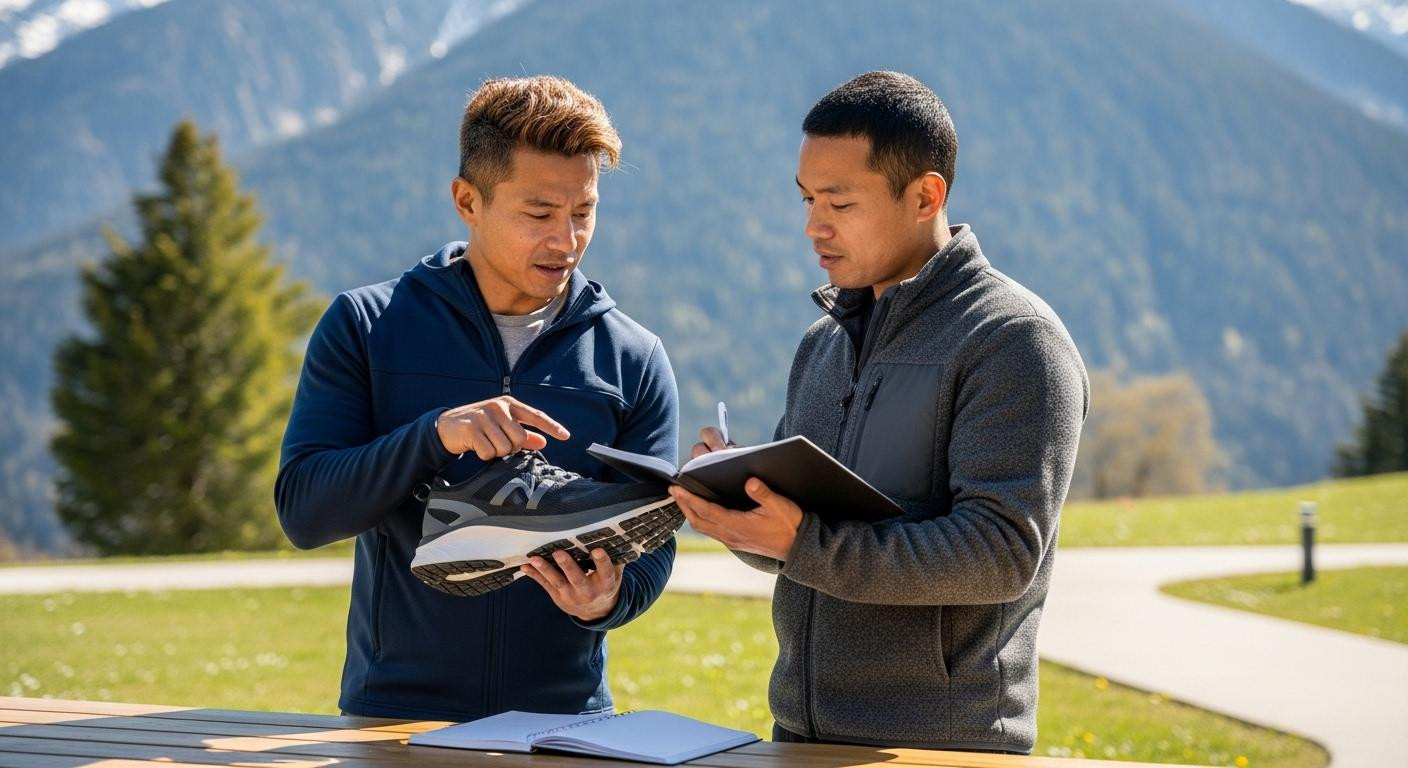Picture two former Salomon employees testing oversized running shoes on Mount Etna’s volcanic trails in 2009. Jean-Luc Diard and Nicolas Mermoud felt frustrated by downhill running’s brutal impact. While skiing and mountain biking equipment made descents thrilling, running shoes offered only pain. Their radical solution would transform alpine innovation into America’s $140 running revolution. From Annecy’s French Alps to California headquarters, HOKA’s journey proves sometimes the best ideas emerge when you stop following conventional wisdom.
The alpine problem two mountain athletes refused to accept
In 2009, Diard and Mermoud were elite mountain athletes based in Annecy, France. They experienced that pivotal moment at Mount Etna where everything clicked. According to sports performance researchers studying downhill biomechanics, traditional running shoes concentrate impact forces that skiing and biking equipment naturally dissipate.
Their insight challenged industry orthodoxy. The minimalist shoe trend dominated 2009-2015 running culture. Barefoot running advocates promoted thin soles and natural foot strike patterns. These French innovators proposed the opposite: maximum cushioning without weight penalties.
They named their creation “HOKA” from the Māori phrase meaning “to fly over land.” This wasn’t marketing speak. The founders literally wanted to replicate that effortless sensation of flying down mountainsides. They tested prototypes on courses as long as downhill slalom runs and measured five-second improvements over traditional footwear.
The science behind oversized foam that shouldn’t work
Rocker geometry changes running physics
HOKA’s signature meta-rocker sole design promotes natural heel-to-toe rolling motion. Biomechanical research conducted at university laboratories demonstrates this geometry reduces ankle muscle activation by 4.5 percent during impact phases. Unlike flat traditional soles requiring active muscle engagement, the curved profile guides foot movement automatically.
Sports scientists studying athletic performance confirm the H-Frame stability system prevents excessive arch compression. This figure-eight EVA structure maintains structural integrity while absorbing 13 percent more impact than average running shoes according to laboratory durometer measurements.
Maximal cushioning without the weight penalty
The counter-intuitive engineering adds 50 percent more sole material without proportional weight increases. Advanced EVA foam compounds maintain cushioning properties through extended use. Models like the Gaviota 5 feature 36mm stack heights that cradle feet from landing to toe-off.
However, research from exercise physiology laboratories revealed unexpected findings. Runners using maximal shoes showed higher impact forces and loading rates compared to traditional footwear. This contradicted initial hypotheses about cushioning reducing injury risk factors.
From French alps to California headquarters
2009-2015 trail running niche to ultramarathon dominance
Elite ultramarathoners adopted HOKA shoes first. By 2010, athletes wearing the brand won three toughest races across three continents without the founders’ knowledge. Trail running specialists appreciated the downhill confidence these shoes provided during technical descents.
Professional trail runners report significant fatigue reductions on descents after switching to maximal cushioning systems. The shoes positioned themselves as performance tools for extreme athletes tackling hundred-mile mountain races. Personal testimonials from recreational runners began documenting similar benefits.
California headquarters and mainstream breakthrough
Deckers Brands acquired HOKA in April 2013, establishing California operations. This geographic transition symbolized cultural shift from alpine specialty to American lifestyle brand. The move provided access to broader distribution networks and marketing resources.
Trail running popularity surged throughout the 2020s as Americans sought outdoor fitness alternatives. The brand simplified from “HOKA One One” to simply “HOKA” in December 2021, signaling mainstream recognition. Professional care recommendations emerged as more Americans invested in premium running footwear.
Why Americans run in shoes designed for French mountains
Alpine problem-solving translated perfectly to American pavement needs. Most recreational runners face identical impact physics whether scaling Alps or jogging suburban sidewalks. The PROFLY+ construction used in models like the Mach 5 delivers responsive cushioning with 5mm heel drops suitable for everyday training.
Americans embraced maximal cushioning despite contradicting minimalist orthodoxy. Functional fitness approaches prioritize sustainable movement over extreme training philosophies. The geographic journey mirrors accessibility: elite mountain innovation evolved into proven science supporting mainstream adoption.
Average HOKA pricing at $140 positions the brand competitively against premium alternatives while delivering measurable performance benefits. Complete runner care systems now incorporate maximal cushioning as essential equipment rather than luxury upgrades.
Your questions about HOKA’s journey from French alps to American streets answered
Why did HOKA founders choose a Māori name for a French brand?
“HOKA” means “to fly over land” in Māori language. The founders selected this name before creating their first prototype. It captured their vision of effortless downhill movement that transcended French or English linguistic boundaries. The universal aspirational meaning reflected their global ambitions from inception.
How do HOKA shoes compare price-wise to other premium running brands?
HOKA averages $140 for popular models like the Clifton 10. This positions them approximately equal to Nike Pegasus pricing but 15 percent lower than advanced Salomon trail shoes. Independent testing confirms HOKA delivers 12 percent more cushioning and weighs 30 grams less than comparable alternatives.
What makes HOKA suitable for everyday runners versus just ultramarathoners?
Clinical studies document 21 percent lower impact injury incidence among recreational runners using maximal cushioning systems. The technology originally designed for extreme alpine conditions proves beneficial for weekend 5K races and daily walking. Lower limb soreness reduces by 30 percent after eight weeks of regular use according to longitudinal research.
Picture Diard and Mermoud sketching those first oversized soles in 2009 Annecy. Their alpine insight now cushions millions of feet across 50 countries. Your next run carries that same effortless downhill dream whether on French mountain trails or American suburban sidewalks.
